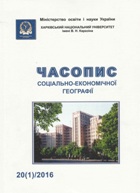Ukrainian steppe and hungarian alfeld as the frontier territories
Abstract
The research paradigm of the frontier virtually is not developed in modern social and geographical studies. However, as the analysis of scientific and historical literature shows, this paradigm has powerful research and cognitive potential. The application of the frontier theory has the greatest prospects in geographic studies of the two European countries –HungaryandUkraine. Wide areas, that for many years used to be typical frontier with all its geopolitical, economic, social and cultural features, extend within the borders of these countries. They are Hungarian Alfeld and Ukrainian steppe.
The article analyzes the evolution of scientific views on the nature of frontier from the founder of the theory of John. F. Turner to the development of modern Hungarian and Ukrainian scientists. The article gives a comparative analysis of colonization of Ukrainian steppe, Alfeld and classic American frontier (Midwest of theUSA) and its common and distinct features on the basis of the understanding of the frontier as a peripheral area, where an interaction and collision of two or more societies (civilizations) take place.
The presence of frontier territories and their colonization had a significant impact on the economic development ofUkraine,Hungaryand theUnited States, had an effect on the formation of national identity and mentality of the population. "Frontier syndrome" has not still lost its impact on the way of life of the population of Alfeld andMidwest, due to their partly-peripheral position as regards to the industrialized regions of these countries. At the same time, the major part of the Ukrainian steppe became one of the most developed regions of the country in the industrial age. However, in terms of social transformation and transition to post-industrial stage, excessive industrialization and specialization in eco-phobia, low-tech sectors of heavy industry (coal, metallurgy, etc.) causes a high level of conservatism in regional society and leeds to serious socio-economic and socio-political challenges.
Downloads
References
2. Vynarchuk, T. (2014). Vnutrishni frontyry na Pivdni Ukrainy (kinets ХІХ – pochatok ХХ st.). Skhid i Pivden Ukrainy: chas, prostir, sotsium: Kolektyvna monohrafiya u 2 t. T 1. K., Instytut istorii Ukrainy NAN Ukrainy, 160- 174.
3. Vermenych, Ya. (2014). Krym i Pivnichne Prychornomorya na tsyvilizatsiynomu perekhresti (VIII st. do n.e. – kinets ХVІІІ st.). Skhid i Pivden Ukrainy: chas, prostir, sotsium: Kolektyvna monohrafiya u 2 t. T 1. K., Instytut is-torii Ukrainy NAN Ukrainy, 126-159.
4. Vlasti Zabaykalya podtverdili peregovory s kitaytsami ob arende zemli. Avialable at: http://www.vedomosti.ru/business/news/2015/06/16/596550-vlati-zabaikalya-podtverdili-peregovori-s-kitaitsami-ob-arende-zemli.
5. Infografika: Osvoyennya pivdnya ta skhodu suchasnoi Ukrainy. Avialable at: http://nv.ua/ukraine/events/opublikovana-infografika-razvenchivajushchaja-mify-rossii-o-juge-i-vostoke-ukrainy-62851.html
6. Chornovol, I. (2009). Teoriya komparatyvnykh frontyriv. Regionalna istoriya Ukrainy. Zbirnyk naukovykh statey, 3, 41-66.
7. Chutkyy, A.I. (2015). Narysy z ekonomichnoi istorii Ukrainy. Knyha 2. Stanovlennya zhytnytsi Evropy (druha polovyna XV – XVII st.). K., Tempora, 368.
8. Polovinu Tunguro-Olekminskogo rayona otdadut v arendu kitaitsam. Avialable at: http://zab.tv/news/obshchestvo/polovinu-tungiro-olekminskogo-rayona-otdadut-v-arendu-kitaytsam.
9. Beluszki, P. (2001). A Nagyalföld történeti földrajza. Budapest – Pécs: Dialóg Campus, 274.
10. Haggett, P. (2001). Geography. A Global Synthesis. Pearson Ed. Ltd., Harlow.
11. Heller, M. (1997). Az Orosz Birodalom története. I. Kötet. Budapest: МіК, 448.
12. Hollander, А. (1975). A magyar Alföld és Turner „frontier” hipotézise. Budapest: Ethnographia, 86/2, 3, 313-321.
13. Kovács Z. Népesség- és településföldrajz. – Budapest: ELTE Eötvös Kiadó, 2002 . – 239 о.
14. Lattіmore, O. (1962). Іnner Asіan Frontіers of Chіna. Boston.
15. Nemes-Nagy, J. (1998). Tér a társadalomkutatásban. Budapest: Hilscher Rezső Szociálpolitikai Egyesület, 195.
16. Probáld, F. (2005). Amerika regionális földrajza. Budapest: Trefort, 360.
17. Rácz, K. (1943). Oroszország története. Budapest: Grill Károly Könyvkiadó Vállalata, 629.
18. Siselina, L., Gazdag, F. (2004). Oroszország és Európa. Orosz geopolitikai szöveggyűjtemény. Budapest: Zrínyi, 446.
19. Subtelny, O. (2000). Ukraine: A History. Toronto – Buffalo – London: University of Toronto Press, 736.
20. Szokolay, K. (1997). Lengyelország története. Budapest: Balassi, 291.
21. Turner, F. (1994). The Sіgnіfіcance of the Frontіer іn Amerіcan Hіstory: Rereadіng wіth commentary by J.M. Faragher. New York.




